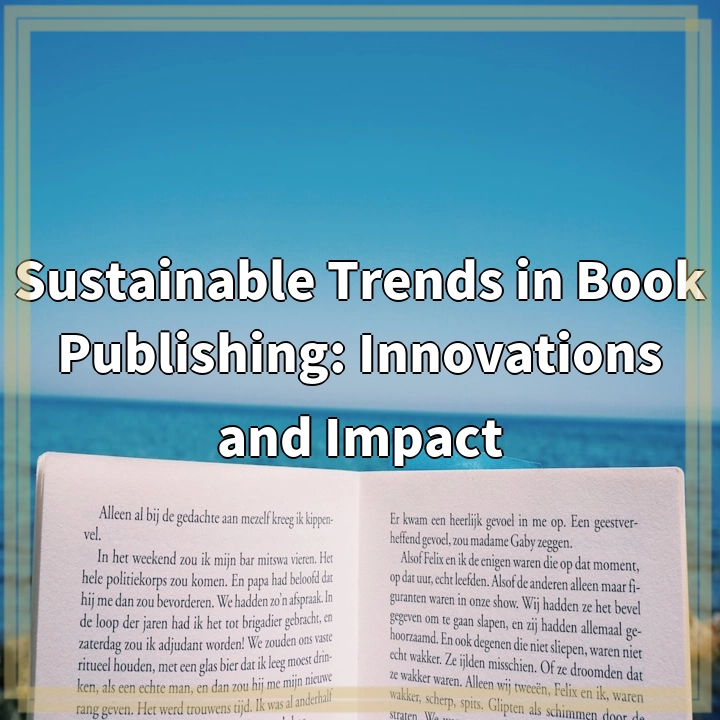
What it is:
Sustainable trends in book publishing refer to the innovative practices and methodologies aimed at reducing the environmental impact of producing, distributing, and consuming books. As the publishing industry increasingly recognizes its role in combating climate change, it is adopting eco-friendly approaches that prioritize sustainability at every stage—from sourcing materials to production techniques and distribution methods. These trends include the use of recycled and responsibly sourced paper, environmentally friendly inks, and energy-efficient printing practices. Additionally, digital publishing is on the rise, reducing the carbon footprint associated with physical book production and distribution.
Key Innovations in Sustainable Publishing
Several key innovations are driving sustainability in the book publishing industry. For instance, many publishers are now leveraging print-on-demand technology, which minimizes waste by only producing books as they are ordered. This not only conserves resources but also reduces excess inventory that often ends up in landfills. Furthermore, the move towards digital formats, such as eBooks and audiobooks, is revolutionizing the way readers consume literature while offering a more sustainable alternative to traditional print.
The Role of Certifications
Industry certifications, such as FSC (Forest Stewardship Council) and SFI (Sustainable Forestry Initiative), are becoming increasingly important in promoting sustainable practices within publishing houses. These certifications help ensure that the materials used in book production are sourced responsibly, and they cater to a growing consumer demand for products that are environmentally friendly. As awareness and concern for sustainability rise among consumers, more publishers are showcasing these certifications in their marketing strategies.
Real-World Problems
Despite the promising trends in sustainable book publishing, several real-world problems persist. One major challenge is the availability and cost of sustainable materials. High-quality, recycled paper and eco-friendly inks can often be more expensive than their conventional counterparts, making it difficult for smaller publishers to adopt these materials without significantly increasing retail prices.
Environmental Impact of Distribution
The distribution of books also poses environmental concerns. The carbon footprint associated with shipping printed materials globally can be substantial. While digital formats help mitigate this issue, they also raise questions about e-waste and the environmental costs of producing electronic devices. Achieving balance in the distribution practices is essential for truly sustainable publishing.
Consumer Awareness and Behavior
Another significant challenge lies in consumer awareness and behavior. While many readers are increasingly concerned about sustainability, they may not always prioritize eco-friendly options when purchasing books. Publishers need to effectively communicate the benefits of sustainable practices to encourage consumers to make environmentally responsible choices. Educating the public can play a crucial role in driving demand for sustainably produced books.
Industry Resistance to Change
Lastly, there is inherent resistance to change within the publishing industry. Established practices and traditional models are often deeply rooted, making it challenging to shift towards more sustainable methods. Publishers may fear that adopting new technologies or practices could be cost-prohibitive or could compromise quality. Overcoming this inertia requires concerted efforts from all stakeholders involved, including authors, publishers, retailers, and consumers.

Solutions for Sustainable Trends in Book Publishing
To address the challenges associated with sustainable trends in book publishing, a multi-faceted approach is necessary. Solutions must focus on overcoming financial obstacles, enhancing consumer education, adopting innovative technologies, and fostering collaboration across the industry.
Cost-Effective Sustainable Materials
One of the first steps in promoting sustainability is to enhance the availability and affordability of eco-friendly materials. Publishers can partner with suppliers who specialize in sustainable resources, which may help reduce costs over time through bulk purchasing and long-term agreements. Additionally, investment in research to develop more affordable alternatives to traditional materials can facilitate broader adoption of sustainable practices.
Eco-Friendly Distribution Methods
Improving distribution methods is crucial in reducing the carbon footprint of book shipping. Publishers can investigate local printing options to minimize shipping distances and support regional economies. Utilizing freight optimization technologies can also help ensure that books are transported using the most efficient routes available, thereby reducing greenhouse gas emissions related to logistics.
Raising Consumer Awareness
To shift consumer behavior towards eco-friendly choices, publishers should invest in marketing campaigns that emphasize the benefits of sustainable publishing. Highlighting the environmental impact of their practices through engaging storytelling can effectively resonate with consumers. Publishers could also provide transparent communication about their sustainability initiatives, certifications, and the lifecycle of products to bolster trust and encourage eco-conscious purchasing habits.
Promoting Industry Collaboration
Encouraging collaboration within the publishing industry can lead to widespread adoption of sustainable practices. Joint initiatives, such as sharing best practices and resources, can empower smaller publishers to embrace eco-friendly solutions. Industry associations and networks can play a vital role in fostering dialogues around sustainability and building a sense of community that drives change.
Embracing Technological Innovations
Adopting innovative technologies such as print-on-demand and digital publishing formats can significantly reduce waste and promote sustainability. Publishers should explore leveraging cloud-based publishing platforms that can streamline workflows and decrease the environmental impact. Continued investment in technological advancements will provide the insights and tools needed to enhance eco-friendly practices throughout the industry.















